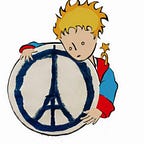French Cinema: Mr Hulot’s Holidays (1953)
by Jacques Tati (Director). Movie Theme: “ How is the Weather in Paris? ” By Alain Romans (Composer and pianist)
The Movie and the Director
“Mr. Hulot’s Holidays” was shot in 1951 and released 1953 by French director Jacques Tati, who for his second movie, introduced the recurring character of Mr. Hulot, who would feature in his later movies (My Uncle, Play Time, Traffic).
In “Mr. Hulot’s Holidays”, the character of Mr. Hulot is a dreamy, eccentric and unpredictable Parisian who has decided to spend a holiday by the French seaside at the peak of the summer.
The movie begins with Hulot finally reaching his destination in an old fuming jalopy. Barely has he registered at the “Hôtel de la Plage” that disasters happen one after the other. Despite his kindness and good will, Hulot brings chaos and confusion to the resort and to its guests desperately trying to enjoy their holidays.
“Mr. Hulot’s Holidays” does not contain any actual dialogues. Jacques Tati became famous for shooting movies with no dialogues, instead fitting them with a heavy sound editing and a rich film score. In Mr. Hulot’s Holidays, this way of shooting played a determinant role in creating a particular atmospheric comedy.
The director Jacques Tati (1907–1982) started his career as a mime and music hall entertainer and later on directed short movies until his first full-length movie “Jour de Fête” in 1949. Tati agreed that he was one of the last directors representing the Burlesque genre, whose main actors included first Little Tich, Buster Keaton and Charlie Chaplin and later Laurel & Hardy or the Max Brothers.
Alain Romans
The composer of the music score was Alain Romans (1905–1988), who subsequently worked with Tati on the equally famous movie “My Uncle” (1959).
Alain Romans’ life reads like an adventure novel.
Romans was born in Poland in 1905, studied music in Berlin and Leipzig and spent most of his life in France. By the 1930’s, Romans was a well-established movie composer and radio artist. Between 1931 and 1938, he was a regular host at Parisian venues such as “La Jungle”, “Chez Michel” or at the “Derby” along with Django Reinhardt. Besides performing at night, Romans also wrote the music for several movies such as “Prisonnier de mon Coeur” (1932), “Zouzou” with Jean Gabin (1934) or Princess Tam Tam featuring the famous actress Josephine Baker (1935) and be playing on the radio.
During the Second World War, Romans originally spent the “Phoney War” as a conscript. Following the defeat of France, he managed to reach the UK through Gibraltar. Once in London, he joined the British Special Services thanks to his language skills (Romans was proficient in French, German and Polish).
While on a secret mission in France, Romans was captured with his squad by the German Kriegsmarine and ended up interrogated and tortured for a week. Unlike his other companions, he was lucky enough to miraculously survive an actual execution. Left for dead, sailors noticed that he was moving and rescued him before throwing his body overboard.
Thanks to the help of local French people, Romans could recover and decided to get back to London. Unfortunately, he was captured again and deported to Treblinka and later to Kaunas’ extermination camp in Lithuania. From there, Romans could escape the camp and went beyond the Russian lines. He eventually went to Murmansk above the Artic Circle and could embark on a ship bound for Liverpool.
Back in England, Romans served again the Intelligence Services and joined the Free French Forces led by General de Gaulle. With de Gaulle, he helped free France and was part of the Italy campaign, the fight for the Liberation of France etc.
After the war, Romans went back to his life as a musician and hardly ever evoked this part of his life. He once explained that he did not want to earn extra money by publicizing this part of his life and consciously made an extra effort to remain discrete about it.
During the post-war years, Romans went back to performing in piano bars such as the “Boeuf sur le Toit” again with Django Reinhardt (between 1947 and 1948). By the mid 1950’s, he played with is band “Alain Romans Et Ses Rythmes” at the legendary “Gaumont Palace” and had started his fruitful collaboration with Jacques Tati.
The Main Theme of “Mr. Hulot’s Holidays”
Alain Romans’ Music theme of the 1953 “Mr. Hulot’s Holidays” is a time capsule that will bring you back the France in the early 1950’s.
Originally called “How Is The Weather In Paris?” , the theme associates the character of Mr. Hulot with the beach, the sea waves and the Dolce Vita in general.
With its jazzy arrangement loosely inspired by Django Reinhardt, the track is a radiant hymn to the enjoyment of lazy days. The theme is played whenever Mr. Hulot appears. His relaxed and indifferent attitude contrasts starkly with the other holidaymakers, who keep listening to boring speeches broadcasted from their Paris radio-station. This behavior of the “Hôtel de la Plage” guests echoes that of many holidaymakers of our era unable to switch off their smart phones during a holiday break.
Likewise the theme also turns nostalgic when played towards the end of the holidays / movie while showing us a last glimpse the now emptied beach.
I remember clearly how good I felt watching this movie when I was a child, although I do not recollect anything particular about the story. More significantly, I particularly loved the mix of sounds, slapstick humor and the main theme, which sticks to you like a caramel candy long after the movie is over.
